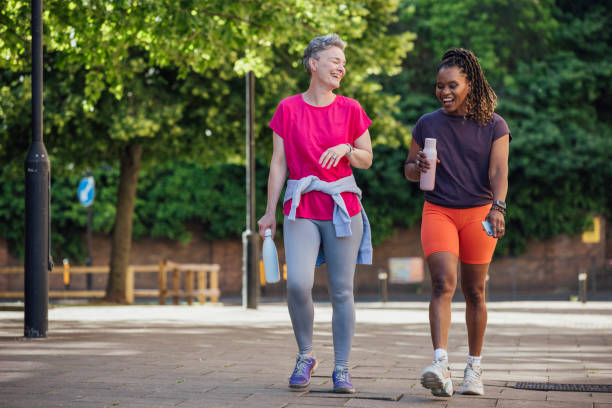Walking Exercise: Benefits, Techniques, and Tips for a Healthier Life
Walking is one of the most natural and accessible forms of exercise, requiring no special equipment, gym membership, or advanced athletic ability. Despite its simplicity, walking offers profound benefits for physical health, mental well-being, and overall longevity. Whether you're strolling through a park, power-walking through your neighborhood, or hiking a mountain trail, this low-impact activity can significantly enhance your quality of life. Research from the American Heart Association confirms that walking just 30 minutes a day can reduce the risk of heart disease, stroke, and diabetes while improving mood and cognitive function.

This comprehensive guide explores the science-backed benefits of walking, proper techniques to maximize efficiency, and practical tips to incorporate more steps into your daily routine.
The Remarkable Health Benefits of Walking
1. Cardiovascular and Metabolic Health
Regular walking strengthens the heart, improves circulation, and helps regulate blood pressure. A Harvard Medical School study found that walking at a moderate pace for at least 150 minutes per week can lower the risk of cardiovascular disease by 31% . Additionally, walking enhances insulin sensitivity, making it an effective strategy for managing and preventing type 2 diabetes. The rhythmic movement of walking helps lower LDL (bad cholesterol) while increasing HDL (good cholesterol), contributing to better metabolic health .
2. Weight Management and Muscle Tone
Unlike high-intensity workouts that may strain joints, walking provides a sustainable way to burn calories and maintain a healthy weight. A 160-pound person can burn approximately 100 calories per mile walked, depending on speed and terrain . Over time, consistent walking helps tone leg muscles, strengthens the core, and improves posture. Uphill walking or adding intervals of brisk walking can further enhance calorie expenditure and muscle engagement .
3. Mental Health and Cognitive Benefits
Walking has been shown to reduce symptoms of anxiety, depression, and stress by stimulating the release of endorphins, the body’s natural mood elevators. A 2019 study in JAMA Psychiatry revealed that walking for 35 minutes a day, five times a week, significantly reduced depressive symptoms in participants . Moreover, walking boosts brain function by increasing blood flow to the brain, which may lower the risk of cognitive decline and Alzheimer’s disease. A University of California study found that older adults who walked regularly had larger brain volumes in memory-related areas compared to sedentary individuals .
4. Joint Health and Longevity
Contrary to the misconception that walking wears down joints, it actually helps lubricate them and strengthens surrounding muscles, reducing the risk of arthritis. A Stanford University study tracked 50,000 walkers over a decade and found that those who walked regularly had fewer joint issues than non-walkers . Furthermore, walking has been linked to increased lifespan—research from the Mayo Clinic suggests that brisk walkers may live up to 20 years longer than those with sedentary lifestyles .
Proper Walking Techniques for Maximum Benefits
1. Posture and Alignment
Head & Neck: Keep your head up, eyes forward, and chin parallel to the ground to avoid straining the neck.
Shoulders: Relax them, pulling slightly back to prevent hunching.
Arms & Hands: Bend elbows at 90 degrees and swing them naturally; avoid clenching fists.
Core: Engage abdominal muscles slightly to support the lower back.
Hips & Stride: Take natural steps, landing on the heel and rolling through to the toes. Avoid overstriding, which can cause strain .
2. Breathing Rhythm
Proper breathing enhances endurance and oxygen flow. Inhale deeply through the nose for 2-3 steps, then exhale through the mouth for the same count. If walking briskly, switch to rhythmic mouth breathing for better efficiency .
3. Footwear Matters
Wearing proper walking shoes with arch support, cushioning, and a flexible sole prevents injuries. Experts recommend replacing walking shoes every 300-500 miles to maintain support and shock absorption .
4. Increasing Intensity
To elevate the workout:
Speed Walking: Aim for 3.5–4.5 mph to raise heart rate.
Incline Walking: Hills or treadmill inclines engage glutes and calves more.
Interval Walking: Alternate between 1 minute of brisk walking and 2 minutes of moderate pace for calorie burn.
Tips to Incorporate More Walking Into Daily Life
1. Set Realistic Goals
Start with 10-15 minutes daily and gradually increase to 30-60 minutes. The CDC recommends at least 7,000–10,000 steps per day for optimal health benefits .
2. Make It Social
Walking with a friend, family member, or dog increases accountability and enjoyment. Join a local walking group or charity walks like Walk for a Cause events.
3. Walk Instead of Drive
Park farther from entrances.
Take stairs instead of elevators.
Walk during phone calls or work breaks (try a walking desk if possible).
4. Use Technology Wisely
Fitness Trackers (Fitbit, Apple Watch) monitor steps, heart rate, and progress.
Apps like MapMyWalk track routes and calories burned.
Podcasts/Audiobooks make long walks engaging.
5. Explore Nature (Shinrin-Yoku – Forest Bathing)
Walking in green spaces reduces cortisol levels and enhances mental clarity. Japanese research on forest bathing shows that 20 minutes in nature lowers stress hormones significantly .
Conclusion: Walking as a Lifelong Habit
Walking is more than just exercise—it’s a free, sustainable, and enjoyable way to boost physical and mental health at any age. From reducing chronic disease risks to enhancing creativity and emotional well-being, its benefits are unmatched in simplicity and effectiveness. By adopting proper techniques, setting achievable goals, and finding ways to make walking a natural part of daily life, anyone can harness its transformative power. So lace up your shoes, step outside, and let each stride take you closer to a healthier, happier life.
Photo from iStock
0 Comment to "Walking Exercise: Benefits, Techniques, and Tips for a Healthier Life"
Post a Comment